| |
Absolute Pitch.
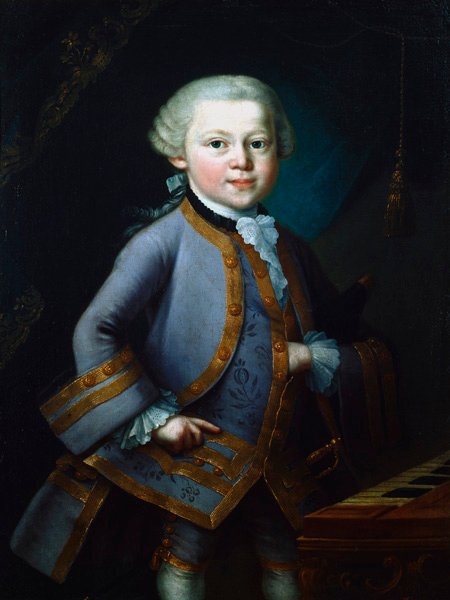
In the summer of 1763, the Mozart family embarked on the famous tour of Europe that established the young composer’s reputation as a musical prodigy. Just before they left, an anonymous letter appeared in the Augsburgischer Intelligenz-Zettel describing seven year old Wolfgang’s extraordinary abilities. The letter included the following:
‘Furthermore, I saw and heard how, when he was made to listen in another room, they would give him notes, now high, now low, not only on the pianoforte but on every other imaginable instrument as well, and he came out with the letter of the name of the note in an instant. Indeed, on hearing a bell toll, or a clock or even a pocket watch strike, he was able at the same moment to name the note of the bell or time piece.’1
This passage provides a good characterization of absolute pitch – the ability to name or produce a note of a given pitch in the absence of a reference note2. This ability, which is also known as ‘perfect pitch’, is very rare in our culture, with an estimated overall prevalence of less than one in ten thousand. People with absolute pitch name musical notes as rapidly and effortlessly as most people name colors. Yet absolute pitch is often regarded as a mysterious endowment that is available only to a few gifted individuals. This impression is strengthened by the fact that many famous musicians, such as Bach, Beethoven, Handel, Menuhin, Toscanini, Boulez, and so on, were known to possess this ability.
In contrast with the rarity of absolute pitch, the ability to judge one musical note in relation to another is very common. So, for example, most musicians, when presented with the note F and given its name, have no difficulty in naming the note two semitones higher as G, the note four semitones tones higher as A; and so on. (A semitone is the pitch relation formed by two adjacent notes on a keyboard) What most people, including most musicians, cannot do is name a note when they hear it out of context.
As someone with absolute pitch, it has always seemed puzzling to me that this ability should be so rare. When we name a color, for example as green, we do not do this by viewing a different color, determining its name, and comparing the relationship between the two colors. Instead, the labeling process is direct and immediate. Consider, also, that note naming involves choosing between only 12 possibilities; namely the 12 notes within the octave (termed pitch classes) shown in Figure 1. This should not be difficult; indeed, it should be trivial for professional musicians, who spend many thousands of hours reading musical scores, playing the notes they read, and hearing the notes they play. As another point, most people can easily identify well-known melodies when they hear them; yet the amount of information required to do this is vastly greater than is needed to name a single note. A lack of absolute pitch, viewed from this perspective, appears akin to color anomia3, in which the person can recognize and discriminate between colors, yet cannot associate them with verbal labels. So the realmystery of absolute pitchis not why some people possess this ability, but instead why it is so rare.4
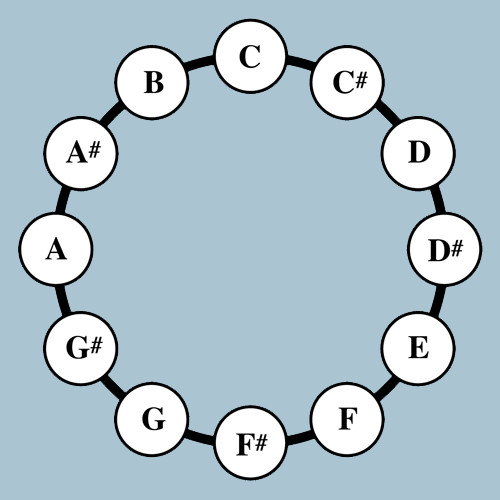
|
Fig. 1. The pitch class circle. The notes of the traditional Western musical scale are produced by dividing the octave into 12 semitone steps. The entire scale is generated by repeating this series of note names (or ‘pitch classes’) across octaves. When people with absolute pitch identify notes by name, they are identifying the positions of the tones along the pitch class circle.
|
Background
Although absolute pitch is most prevalent among highly accomplished musicians, nonpossessors have been shown to possess an implicit form of absolute pitch, even though they cannot label the notes they are judging.
The Tritone Paradox provides a good example of implicit absolute pitch. The basic pattern that produces this illusion consists of two successively presented tones that are related by a half-octave (an interval known as a tritone). The composition of the tones is such that their note names are clearly defined, but they are ambiguous with respect to which octave they are in. So, for example, one tone might clearly be a C, but in principle it could be Middle C, or the C an octave above, or the C an octave below. So when listeners are asked to judge whether a pair of such tones forms an ascending or descending pattern, there is literally no correct answer.
I found that, surprisingly, when one such tone pair is played (say, D followed by G#) some listeners clearly hear an ascending pattern, whereas other listeners clearly hear a descending one. Yet when a different tone pair is played (say, F# followed by C) the first group of listeners now hears a descending pattern whereas the second group now hears an ascending one. Furthermore, for any given listener, the pitch classes generally arrange themselves perceptually with respect to height in a systematic way: Tones in one region of the pitch class circle are heard as higher, and those in the opposite region as lower.5
There is other evidence that people who do not possess absolute pitch as conventionally defined nevertheless possess this ability in implicit form. In one study6, musically trained listeners were presented with excerpts of Bach preludes, and 30% of those without absolute pitch were able to differentiate the correct version from one that had been pitch-shifted by a semitone. Other research7, 8 has shown that people without absolute pitch tend to be fairly consistent in the pitches with which they hum or sing familiar songs on different occasions; further, when asked to sing a popular song that had been recorded in only one key, they produce pitches that are close to those in the recorded version.
Given the evidence for implicit absolute pitch, the inability of most people to label isolated notes is indeed baffling. The evidence strongly indicates that the problem is not one of long term memory for pitch, but is instead related to verbal labeling, and so to speech processing. We shall be examining this conjecture in detail below.
The genesis of absolute pitch
Given the rarity of absolute pitch, there has been considerable speculation concerning its genesis2. One view, which has been championed for over a century, is that this ability is available only to rare people who have a particular genetic endowment, and that it becomes manifest in these people as soon as circumstances allow. There are two general arguments for this view: First, absolute pitch generally appears at a very young age, often when the child has had little or even no formal musical training;second, the ability often runs in families. The problem with both these arguments is that there are alternative explanations in terms of very early childhood exposure: Babies born into families whose members have absolute pitch would frequently be exposed to pitches in association with their names very early in life, so that they would have the opportunity to develop this ability at a very young age. Nevertheless, there is an ongoing search for a DNA marker for absolute pitch, though at this writing the search has so far proved unsuccessful.
Others have taken the opposite view; namely that absolute pitch can be acquired by anyone at any time, given intensive practice. Indeed, on browsing the Web you can encounter an impressive number of offers to supply you with training programs for absolute pitch that are guaranteed to produce success. Unfortunately, however, these claims are unsupported by the scientific evidence. The one reliable report of partial success comes from Brady9 who subjected himself to a heroic regimen in which he listened to training tapes for about 60 hours, following which he obtained a score of 65% correct on a test for absolute pitch. At best, Brady’s report underscores the extreme difficulty of acquiring absolute pitch in adulthood, in contrast with its unconscious and effortless acquisition in early childhood.
There is considerable evidence that absolute pitch is associated with early musical training – and the earlier the musical training the stronger the association. In a large scale survey10, 40% of respondents who began music lessons before age 4 stated that they possessed absolute pitch, and this percentage decreased with increasing age of onset of music lessons, so that only 3% of those who began music lessons after age 9 stated that they possessed the ability. Such findings strongly indicate that the acquisition of absolute pitch involves a critical period. Although this period is generally regarded as beginning at age 3 or so, formal musical training cannot reasonably be initiated at a younger age, which leaves open the possibility that absolute pitch might be most readily acquired in infancy.
There is an intriguing parallel between the timetables associated with the acquisition of absolute pitch on the one hand, and of speech and language on the other. Lennenberg11 was the first to argue persuasively that the acquisition of speech involves a critical period. Learning a second language after puberty is self-conscious and labored; and even following many years of experience, a second language that is learned in adulthood is generally spoken with a ‘foreign accent’. Several lines of research have provided strong support for the critical period hypothesis, for both first and second languages. For example, children who were socially isolated early in life, and so were deprived of the opportunity to acquire speech, were unable to acquire normal language when they were later placed in a normal environment. The course of recovery from brain injury at different ages also points to a critical period: The prognosis has been found to be best when the injury occurred before age 6, and very poor after puberty. In other studies it was found that individuals who were given the opportunity to learn a second language in early childhood became most proficient in this language, with proficiency declining with increasing age of initial exposure to the second language, reaching a plateau with initial exposure in adulthood. The timeframe for absolute pitch acquisition, as a function of age of onset of music lessons, appears to be remarkably similar to that for the acquisition of a second language. Although there are critical periods for the development of other functions, no other critical periods have been documented that show the same correspondence, in terms of timeframe, with that for speech and language.
The case for a link between absolute pitch and speech is strengthened by consideration of tone languages, such as Mandarin, Cantonese, and Vietnamese. In these languages, words take on entirely different meanings depending on the lexicaltonesin which they are enunciated, with tones being defined both by their pitch heights as well as by their pitch contours. (In Beijing Mandarin, for example, the first tone is high and level, the second is mid-high and rising, the third is low and initially falling and then rising, and the fourth is high and falling.) This contrasts with nontone languages such as English, in which pitch is employed to convey prosody and emotional tone, but is not involved in determining the meaning of individual words. For example, in Mandarin the word ‘ma’ when spoken in the first tone means ‘mother’, in the second tone means ‘hemp’, in the third tone means ‘horse’, and in the fourth tone means a reproach. So pitches in such languages are employed to create verbal features, analogous to consonants and vowels. Therefore when speakers of Mandarin hear the word ‘ma’ spoken in the first tone and attribute the meaning ‘mother’, or when they hear ‘ma’ spoken in the third tone and attribute the meaning ‘horse’, they are associating a pitch - or a series of pitches - with a verbal label. Analogously, when people with absolute pitch identify the sound of the note F# as ‘F#’, or the note B as ‘B’ they are also associating a pitch with a verbal label.
As a further argument that absolute pitch in tone languages may be packaged in with other features of speech, the brain structures responsible for processing lexical tone have been shown to overlap with those involved in processing phonemes (i.e., vowels and consonants). For example, while the communication of prosodic features of language appears to be a function of the nondominant hemisphere (i.e., the right hemisphere in most righthanders) for speakers of both tone and nontone languages, the processing of lexical tone appears to be a function of the dominant hemisphere (i.e., the left hemisphere in most righthanders)2. So when speakers of tone language perceive pitches and pitch contours as signifying meaningful words, circuitry in the dominant hemisphere is involved. Given the evidence on critical periods for the acquisition of speech, we can then hypothesize that such circuitry is developed very early in life, during the period in which infants acquire other features of their native language. So if the opportunity to form such associations is unavailable during this critical period, these associations later become very difficult to acquire. Indeed, it has even been argued that when infants acquire nontone languages, they learn to disregard absolute pitches, since individual words in nontone languages carry the same meaning regardless of the pitch level in which they are pronounced. I and my colleagues have therefore been examining the conjecture that absolute pitch is initially acquired by tone language speakers as a feature of speech, and that its rarity in speakers of nontone languages such as English can be explained by the lack of opportunity to acquire it in infancy.
Absolute pitch and tone language
If tone language speakers use absolute pitch as a cue to differentiate the meaning of words, then we would expect them to refer to stable and precise absolute pitch templates in reciting the same list of words on different days. In one experiment 12, 13, we tested seven speakers of Vietnamese, none of whom had received any significant musical training. We handed them the same list of ten Vietnamese words to read out on two sessions, which we held on different days. Then for each spoken word, we took pitch estimates at 5 ms intervals, and averaged these pitches along the musical scale, so producing an average pitch for each word. Then for each speaker we calculated the difference between the average pitches produced by each word as it was spoken on the different days, and we averaged the signed differences across the words in the list.
Our results showed remarkable consistencies: All speakers showed averaged pitch differences of less than 1.1 semitone, with two of the seven speakers showing averaged pitch differences of less than a quarter of a semitone. So the speakers must have been referring to precise and stable absolute pitch templates in reciting the list of words.
Sound Demonstrations 1 and 2 illustrate these findings. Demonstration 1 presents two readings of the list by a male subject. The readings have been interleaved so as to enable direct comparisons between the pitches produced by each word on the different days. First we have Word 1 read on Day 1, followed by Word 1 read on Day 2. Next we have Word 2 on Day 1, followed by Word 2 on Day 2; and so on, until all ten words have been presented. Demonstration 2 presents the two readings by a female subject, interleaved in the same way.
 Sound Demonstration1 Sound Demonstration1
 Sound Demonstration 2 Sound Demonstration 2
In our next experiment, we tested 15 speakers of Mandarin, who (with one exception) had also received little or no musical training. All these subjects had grown up in China, and spoke Mandarin as their primary language. One purpose here was to test the generality of our findings to a different tone language. A second purpose was to evaluate their consistency in reciting the word list on different days, compared to reciting it twice in succession, since on the absolute pitch hypothesis we would not expect to see a reduction in consistency with the passage of time. We generated a list of 12 Mandarin words, with each of the four tones occurring three times in the list.
We tested the subjects in two sessions, which we held on different days, but now they read out the word list twice in each session. We calculated four difference scores: Between the first readings on Days 1 and 2; between the second readings on Days 1 and 2; between the first and second readings on Day 1, and between the first and second readings on Day 2.
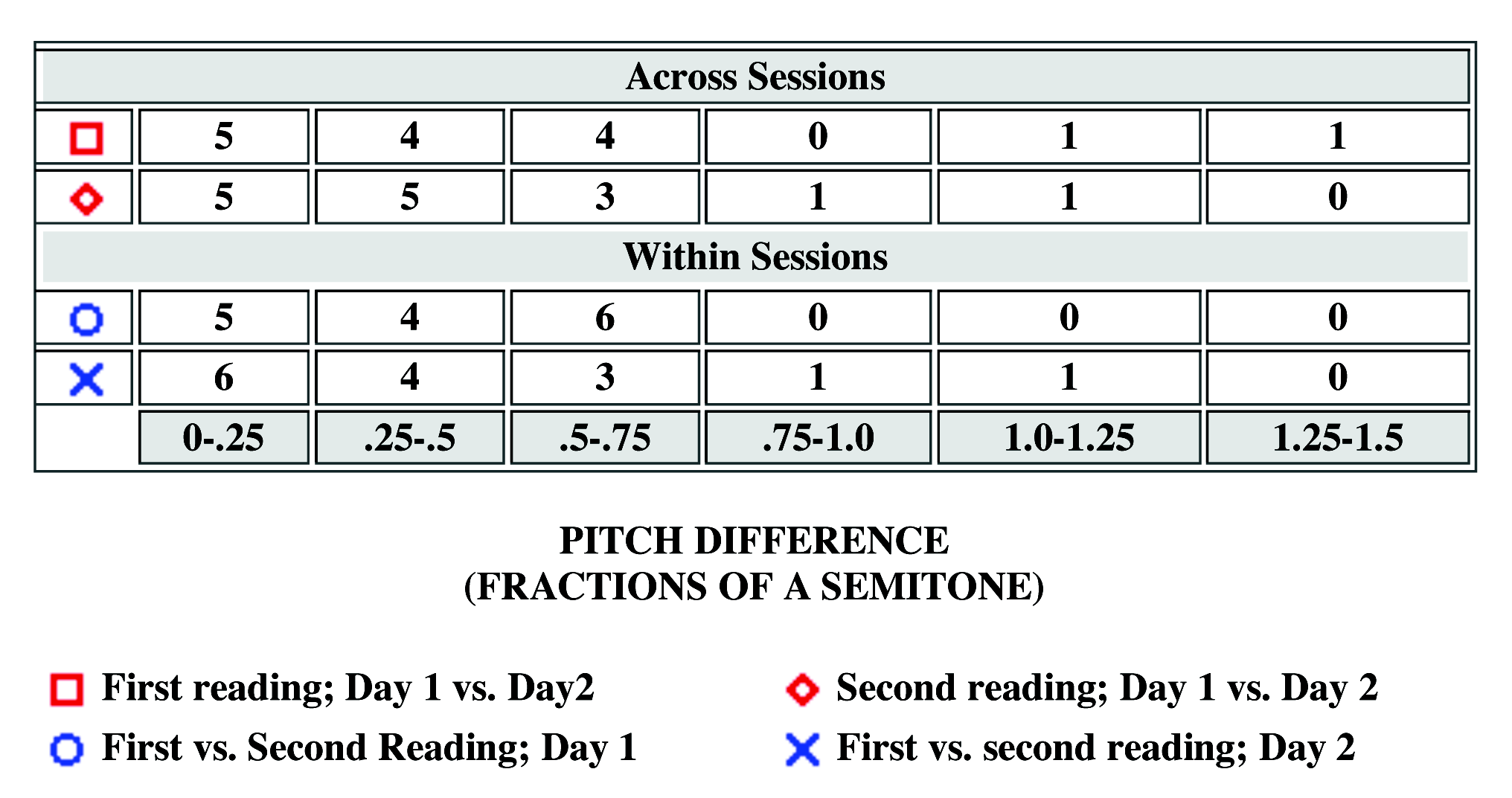
| Table 1. Pitch difference scores produced by native speakers of Mandarin on reading out the same list of Mandarin words on different occasions. The table displays, for each comparison, the number of subjects whose pitch difference scores fell into each 0.25 semitone bin. |
Table 1 shows, for each comparison, the numbers of subjects whose averaged signed difference scores fell into each ¼ semitone bin. We can see that remarkable consistencies were again obtained: For all comparisons, half of the subjects showed averaged pitch differences of less than half a semitone, and one-third of the subjects showed averaged pitch differences of less than a quarter of a semitone. And importantly, there were no significant differences in the degree of pitch consistency in reciting the word list on different days compared with reciting it twice in immediate succession. This leads to the conclusion that although the pitch discrepancies we obtained were very small, they still underestimated the precision of the absolute pitch templates that influenced the subjects’ speech.
Sound Demonstrations 3 and 4 present, for two subjects, the first readings of the word list on Day 1 and on Day 2. In each case, the two readings have been interleaved as before, so as to enable direct comparison between the pitches produced by each word on the different days. Demonstration 3 presents these readings by a male subject, and Demonstration 4 by a female subject.
 Sound Demonstration 3 Sound Demonstration 3
 Sound Demonstration 4 Sound Demonstration 4
These findings show that speakers of Vietnamese and Mandarin possess a remarkably precise form of absolute pitch for the tones of their language, which was here reflected in their enunciation of words. Only one of the subjects in the study had received any significant musical training. We can therefore hypothesize that this ability resulted from their early acquisition of tone language, so that they had learned to associate pitches with meaningful words in infancy. (See also The pitch of speech in tone languagefor a follow-up study showing that, in comparing two linguistic communities where Mandarin is spoken, the pitch level of speech clusters within a given community, but varies across communities.)
So far, I have been arguing for the conjecture that absolute pitch, which has traditionally been viewed as a musical ability, originally evolved to subserve speech. This leads to the further conjecture that when infants acquire absolute pitch as a feature of the tones of their language, and they later reach the age at which they can begin taking music lessons, they can then acquire absolute pitch for musicaltones in the same way as they would acquire the tones of a second tone language. In contrast, children who instead have acquired a nontone language such as English would need to learn the pitches of musical tones as though they were the tones of a first tone language. So, given the findings showing the extreme difficulty in acquiring a first language beyond early childhood, speakers of a nontone language should be at a serious disadvantage in acquiring absolute pitch for musical tones.
This line of reasoning in turn leads to the conjecture that the prevalence of absolute pitch should be much higher among tone language speakers than among speakers of nontone languages such as English. To explore this, my colleagues and I examined the prevalence of absolute pitch in two large groups of music students.14 The first group consisted of 88 first year students who were enrolled in a required course at the Central Conservatory of Music in Beijing. These subjects all spoke Mandarin. The second group consisted of 115 first year students who were enrolled in a required course at Eastman School of Music. These were all nontone language speakers, and both their parents were nontone language speakers. All students who were invited to take the test agreed to do so, and there was no selection of subjects from within either group.
Our test for absolute pitch consisted of the 36 notes that spanned the three-octave range from the C below Middle C to the B almost three octaves above. To minimize the use of relative pitch as a cue, all intervals between successive notes were larger than an octave. The notes were piano samples that were generated on a Kurzweil synthesizer and recorded on CD. The subjects listened to the CD, and identified each note in writing.
The following sound example presents a brief test that was designed as in the experiment
 Play short test for absolute pitch Play short test for absolute pitch
Click here to view the answers (PDF)
 Here is a full test for absolute pitch, similar to the one we use in our experiments, together with the answers. Here is a full test for absolute pitch, similar to the one we use in our experiments, together with the answers.
We divided each group into subgroups by age of onset of musical training, and in order to make meaningful comparisons we considered only those subgroups that contained at least nine subjects. Figure 2 shows, for each of the subgroups, the percentages of subjects who obtained as score of at least 85% on this test. As can be seen, both the Central Conservatory students (that is, the Mandarin speakers) and the Eastman students (that is, the U.S. nontone language speakers) showed orderly effects of age of onset of musical training – the earlier the age of onset, the higher the probability of meeting the criterion for absolute pitch.

| |
Figure 2. Percentages of subjects who obtained a score of at least 85% correct on the test for absolute pitch. CCOM: students at the Central Conservatory of Music, Beijing, China; all speakers of Mandarin. ESM: students at Eastman School of Music, Rochester, New York; all nontone language speakers.
|
It can also be seen that for all levels of age of onset of musical training, the percentage of those who met the criterion was far higher for the Central Conservatory group than for the Eastman group. For students who had begun taking music lessons at ages 4 and 5, approximately 60% of the Mandarin speakers met the criterion, while only 14% of the U.S. nontone language speakers did so. For students who had begun music lessons at ages 6 and 7, approximately 55% of the Mandarin speakers met the criterion, whereas this was true of only 6% of the U.S. nontone language speakers. For those who had begun music lessons at ages 8 and 9, roughly 42% of the Mandarin speakers met the criterion, whereas none of the U.S. nontone language speakers did so. There were no effects of gender.
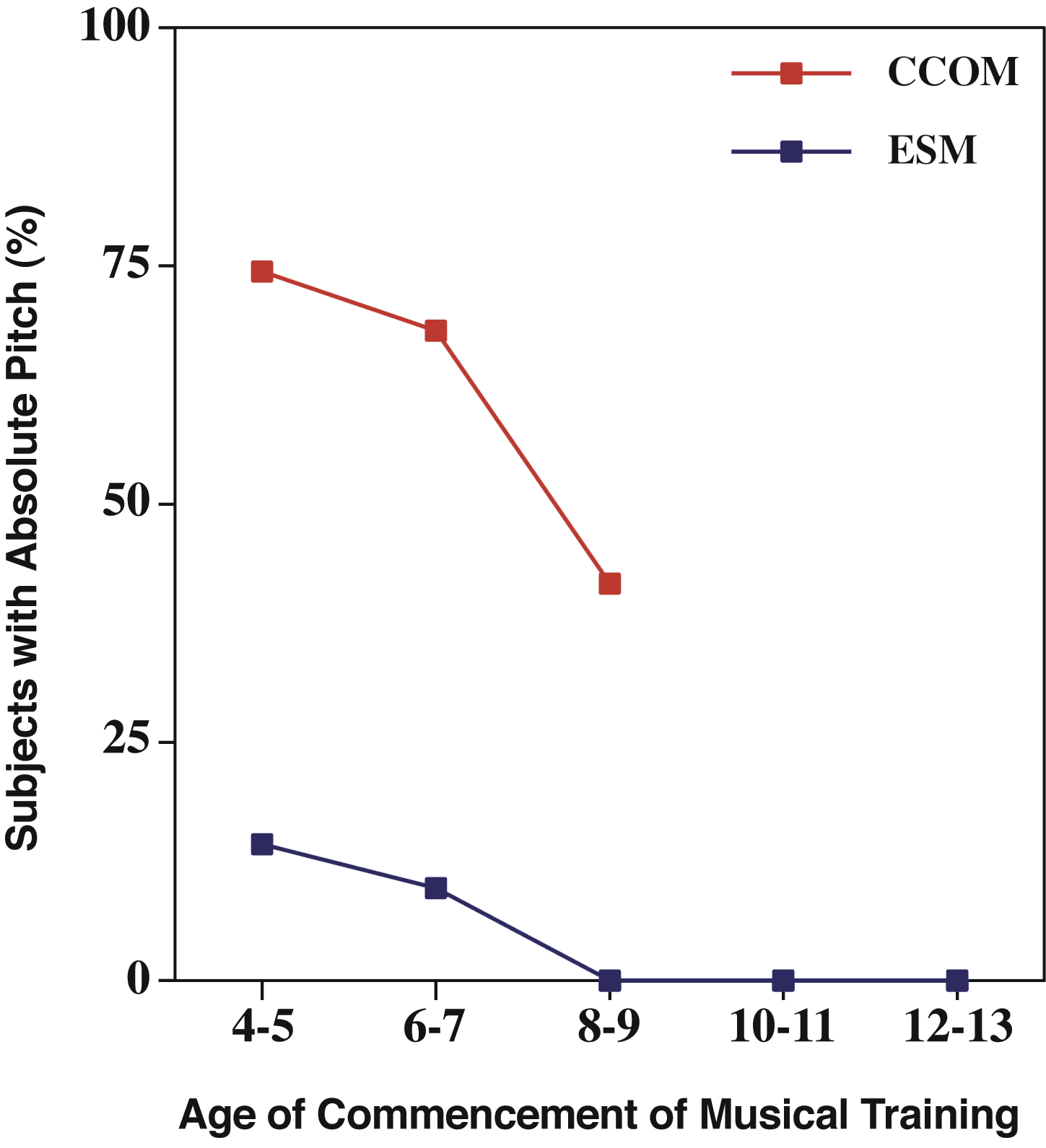
| Figure 3. Percentages of subjects who obtained a score of at least 85% correct on the test for absolute pitch, allowing for semitone errors. CCOM: students at the Central Conservatory of Music, Beijing, China; all speakers of Mandarin. ESM: students at Eastman School of Music, Rochester, U.S.A; all nontone language speakers. |
What happens when we relax the criterion for absolute pitch? Figure 3 displays the percentages of subjects who obtained a score of at least 85% on the same test, but now allowing for semitone errors. Again, it can be seen that both the Central Conservatory and the Eastman students showed orderly effects of age of onset of musical training. And it can also be seen that the difference between the Central Conservatory and the Eastman students was even more extreme.
Recently, my colleagues and I gave the same test to 160 subjects who were first and second year students at the Shanghai Conservatory of Music15. As before, the students were tested in class, without any selection. All the subjects spoke Mandarin. Figure 4 shows the average percent correct on this test, as a function of age of onset of musical training, both allowing and not allowing for semitone errors. As can be seen, there was a large effect of age of onset of training, and in addition the overall performance level was very high. Not allowing for semitone errors, those who had begun music lessons at or before age 5 produced an average of 83% correct, and allowing for semitone errors, they produced an average of 90% correct.
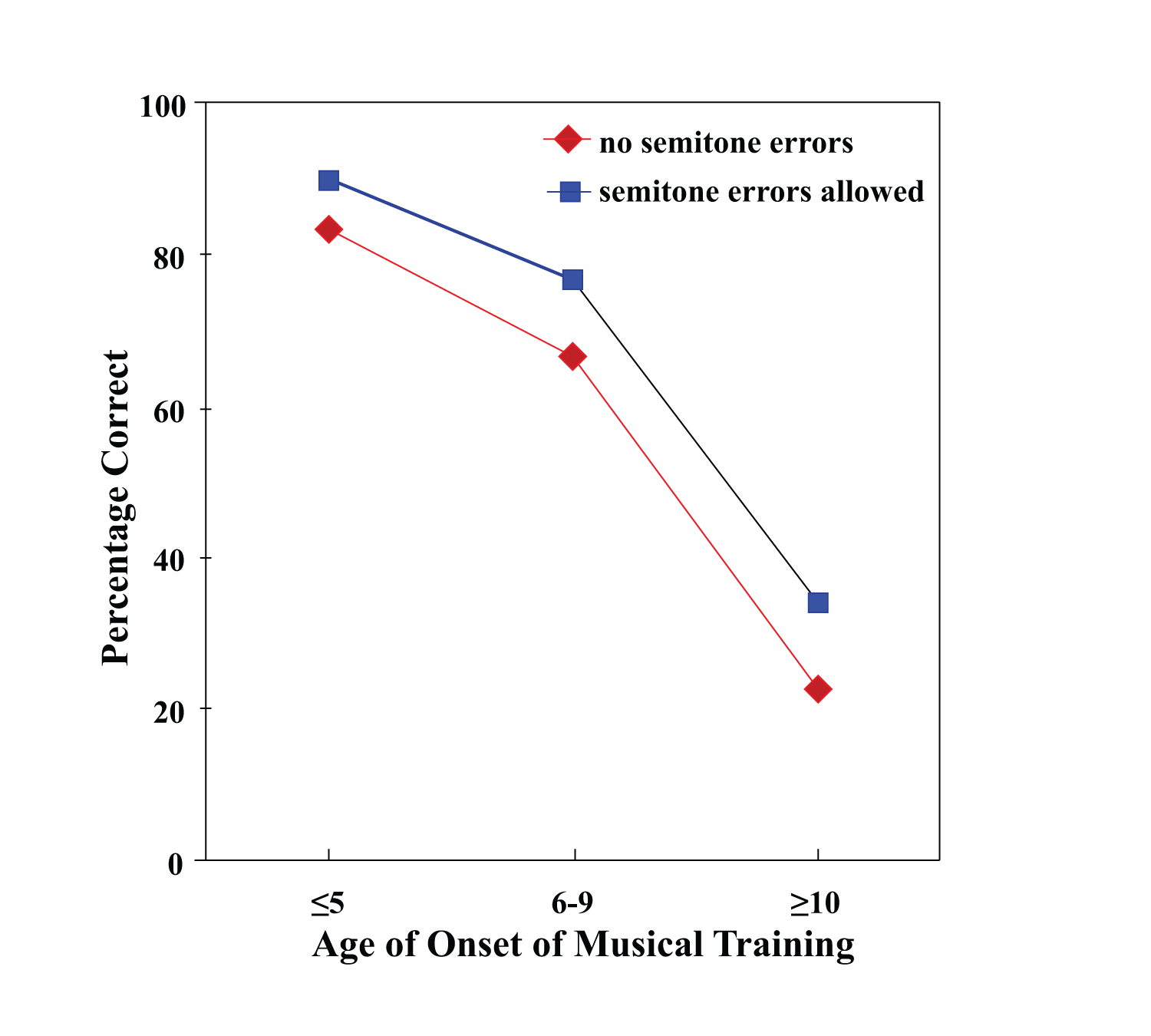
| Figure 4. Average percentage correct on the test for absolute pitch among students at the Shanghai Conservatory of Music. |
These findings support the conjecture that, when given the opportunity, infants can acquire absolute pitch for the tones of their language, so that they can later acquire absolute pitch for musical tones in the same way as they would the tones of a second tone language. In fact, the findings obtained here for the acquisition of absolute pitch in tone and nontone language speakers reflect a very similar picture, in terms of timeframe, to the critical periods inferred by linguists for the acquisition of first and second languages respectively. This supports the hypothesis that, for speakers of tone languages, the acquisition of absolute pitch during musical training is analogous to learning the tones of a second tone language. So speakers of nontone languages such as English, who do not have the opportunity to associate pitches with meaningful words in infancy, are at a disadvantage for the acquisition of absolute pitch for musical tones.
The evidence for this association with language has so far been applied only to speakers of tone languages such as Mandarin and Vietnamese, in which pitch is prominently involved in attributing the meaning of words. However, a related principle might also apply to speakers of other Asian languages such as Japanese and certain dialects of Korean. Japanese is a pitch-accent language, in which the meaning of a word changes depending on the pitches of its constituent syllables. For example, in Tokyo Japanese the word ‘hashi’ means ‘chopsticks’ when it is pronounced ‘high-low’, ‘bridge’ when it is pronounced ‘low-high’, and ‘edge’ when there is no pitch difference between its constituent syllables. In Korean, the Hamkyeng and Kyensang dialects are considered tonal or pitch accent. Pitch accent languages therefore fall somewhere between tone and nontone languages in their use of pitch to determine the meaning of words, It turns out that, as expected from the language hypothesis, speakers of Japanese perform better on tests for absolute pitch than do speakers of nontone language, but not as well as do speakers of Mandarin.16

| Figure 5. Average percentage correct responses on the test for absolute pitch, among students at USC Thornton School of Music. Those in grouups tone very fluent, tone fairly fluent, and tone nonfluent were all of East Asian ethnic heritage. Those in group nontone were Caucasian and spoke only nontone language. |
It might be argued that the high performance levels shown by the Chinese students was genetic in origin, rather than resulting from the acquisition of tone language. To examine this hypothesis, the prevalence of absolute pitch was evaluated amongst students at the University of Southern California Thornton School of Music17. Most of the subjects were Caucasian and speakers of nontone language such as English. The subjects with tone language in their background, and were of East Asian ethnicity, were classified by how fluently they spoke a tone language. Figure 5 shows the average percentage correct for each subgroup. As can be seen, the nontone language speakers showed a very low performance level on the test. In contrast, among those with tone language in their background, those who reported that they spoke a tone language ‘very fluently’ performed very well. Those who reported that they spoke a tone language ‘fairly fluently’ performed less well, but still better than the nontone language speakers. However, the performance of those who reported that they did not speak a tone language fluently was no better than that of the Caucasian nontone language speakers. Moreover, the performance of the ‘tone very fluent’ subjects - who had their music education in the U.S. - was slightly (though not significantly) higher than that of the Beijing group we had studied earlier, showing that the high performance level of the Beijing group cannot be attributed to their country of music education.
Finally, the question still remains of why, among speakers of nontone language such as English, a few individuals with early age of onset of musical training acquire absolute pitch, whereas most others, with equivalent age of onset and duration of musical training do not do so. In one study18 we found that a group of English-speaking absolute pitch possessors displayed an unusually large memory for spoken words. We used as our measure
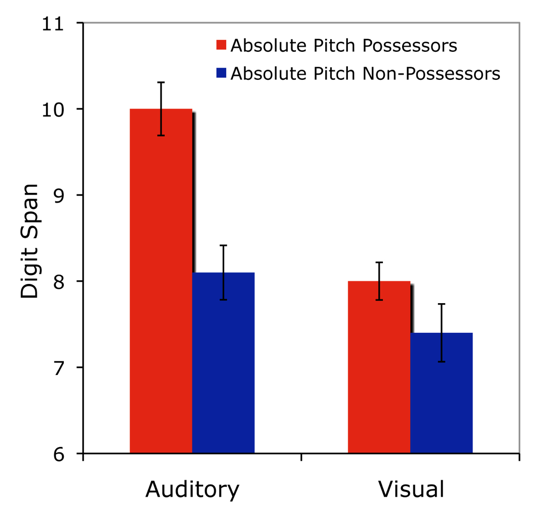
Figure 6. Average scores on the auditory and visual digit span tests, produced by English-speaking absolute pitch possessors and nonpossessors, with the two groups matched for age, and for age of onset and duration of musical training.
|
the auditory digit span, which measures how many digits a person can hold in memory and recall in correct order. We compared the performance of absolute pitch possessors on this test with that of a control group of subjects with equivalent age of onset and duration of musical training, and equivalent education level. The absolute pitch possessors substantially outperformed the nonpossessors on this test. Interestingly, though, the two groups did not differ significantly on the visual digit span.
The strong memory for spoken words found in this study could foster the development of associations between musical notes and their spoken names early in life, and so facilitate the acquisition of absolute pitch. The results of this study also point to a genetic contribution to absolute pitch in the case of nontone language speakers, since the auditory digit span has been found by others to have a genetic basis. The results also provide evidence that musical ability and language ability can go hand in hand – an argument that has also been made in other contexts.
Footnotes
1. Some portions of this review were first published in: Deutsch, D. The Enigma of Absolute Pitch. Acoustics Today, 2006, and Deutsch, D. Absolute pitch In D. Deutsch (Ed.). The psychology of music, 3rd Edition, 2013.
2. The portrait at the top of this entry is “The boy Mozart”, by Pietro Antonio Lorenzoni, 1763.
References for further reading
1. Deutsch, E. O. Mozart: A documentary biography. 3rd edition, 1990, London: Simon and Schuster.
2. Deutsch, D. Absolute pitch. In D. Deutsch (Ed.). The psychology of music, 3rd Edition, 2013, 141-182, San Diego: Elsevier. [PDF Document] [Web Link]
3. Geschwind, N. and Fusillo, M. Color-naming defects in association with alexia. Archives of Neurology, 1966, 15, 137-146.
4. Deutsch, D. The Enigma of Absolute Pitch. Acoustics Today, 2006, 2, 11-18, [PDF Document]
5. Deutsch, D. Paradoxes of musical pitch. Scientific American, 1992, 267, 88-95, [PDF Document]
6. Terhardt, E., and Seewann, M. Aural key identification and its relationship to absolute pitch. Music Perception, 1983, 1, 63-83.
7. Halpern, A. R. Memory for the absolute pitch of familiar songs. Memory & Cognition, 1989, 17, 572-581.
8. Levitin, D. J. Absolute memory for musical pitch: Evidence for the production of learned melodies. Perception & Psychophysics, 1994, 56, 414- 423.
9. Brady, P. T. Fixed scale mechanism of absolute pitch. Journal of the Acoustical Society of America, 1970, 48, 883-887.
10. Baharloo, S., Johnston, P. A., Service, S. K., Gitschier, J., and Freimer, N. B. Absolute pitch: An approach for identification of genetic and nongenetic components. American Journal of Human Genetics, 1998, 62, 224-231.
11. Lennenberg, E. H. Biological Foundations of Language. 1967, New York: Wiley.
12. Deutsch, D., Henthorn, T. and Dolson, M. Tone language speakers possess absolute pitch. Invited Lay language paper, 138th meeting of the Acoustical Society of America, Columbus, Ohio 1999.
13. Deutsch, D., Henthorn T. and Dolson, M. Absolute pitch, speech, and tone language: Some experiments and a proposed framework. Music Perception, 2004, 21, 339-356, [PDF Document]
14. Deutsch, D., Henthorn, T., Marvin, E., & Xu H-S. Absolute pitch among American and Chinese conservatory students: Prevalence differences, and evidence for a speech-related critical period. Journal of the Acoustical Society of America, 2006, 119, 719-722, [PDF Document]
15. Deutsch, D., Li, X., and Shen, J. Absolute pitch among students at the Shanghai Conservatory of Music: A large-scale direct-test study. Journal of the Acoustical Society of America, 2013, 134, 3853-3859, [PDF Document] [Web Link]
16. Miyazaki, K., Makomaska, S., and Rakowski, A. Prevalence of absolute pitch: A comparison between Japanese and Polish music students. Journal of the Acoustical Society of America, 2012, 132, 3484-3493.
17. Deutsch, D., Dooley, K., Henthorn, T. and Head, B. Absolute pitch among students in an American music conservatory: Association with tone language fluency. Journal of the Acoustical Society of America, 2009, 125, 2398-2403, [PDF Document]
18. Deutsch, D., and Dooley, K. Absolute pitch is associated with a large auditory digit span: A clue to its genesis. Journal of the Acoustical Society of America, 2012, 132, 1886, [PDF Document]
19. Deutsch, D. The mystery of absolute pitch. Chapter 6 in: Musical Illusions and Phantom Words: How Music and Speech Unlock Mysteries of the Brain, Oxford University Press. 2019.
20. Deutsch, D. The mystery of absolute pitch.Chapter 6 In Musical Illusions and Phantom Words: How Music and Speech Unlock Mysteries of the Brain, Korean translation, Eidos Publishing Group , 2023.
21. Deutsch, D. The mystery of absolute pitch.. Chapter 6 in Musical Illusions and Phantom Words: How Music and Speech Unlock Mysteries of the Brain, Chinese translation, 2024, Guangxi Normal University Press, Group Co, Ltd., 2024.
22. Deutsch, D. (Ed.). Absolute pitch, Chapter 5 in: The Psychology of Music, 3rd Edition, San Diego: Elsevier, 2013.

| |